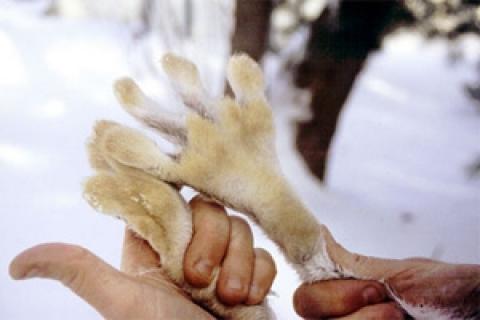
Winter in the north can be an awfully long season. Ice fishing, tying flies and the planning of hunts certainly make it more enjoyable, but sometimes even these things won't cure cabin fever. That's when I go hunting for snowshoe hares.
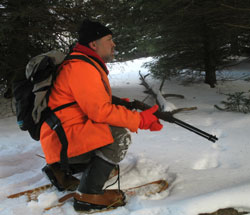 |
| Contrary to tradition, author Steve Galea prefers a .22 rifle over a shotgun when snowshoe hare hunting. |
Some hunters wouldn't dream of hunting hares without at least one beagle. There's no doubt that a good rabbit dog adds to the experience on many levels. The tonguing of a trusty hound hot on a hare's trail is a type of music that's hard to describe. Unfortunately, my quota of hunting dogs is already filled by my English Springer spaniel and Labrador retriever. So, no matter how much I'd like one, a beagle is out of the question. Luckily, there are other equally enjoyable ways to hunt hares.
Some of my most memorable hare hunts, in fact, have occurred while I have prowled along the thickets with my favorite .22 rifle in hand. It might not be as productive as teaming up with a brace of experienced hounds, but it is a test of your still hunting skills and marksmanship. More than that, it's an excellent way to make the most of a winter's day.
When in Rome do as the Snowshoe Hare Does
We've all heard the saying, "When in Rome, do as the Romans do." Well, I believe the same advice applies when you are in snowshoe hare country. Most times, in mid-winter, the snow is deep in the fields, woods, and cedar swamps around my house. Too deep, in fact, for a short-legged hunter, like myself, to traverse it without getting soaked or exhausted. Then again, why walk in the snow when you can walk on it?
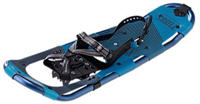 |
| Great snowshoe choices for men and ladies at Bass Pro Shops. |
Enter the need for a set of snowshoes. They work for big-footed hares, so why not you too? Use the smallest, most maneuverable pair that you can get away with. I employ a traditional set of bear paw snowshoes that I have had since I was seventeen. They've seen a lot of seasons and are patched up, but they can take me though the thickets and cedar swamps as good as anything. My son just received a new pair of space-aged aluminum snowshoes and we are quite impressed with their performance in the winter woods and swamp edges as well.
I won't detail the need to dress accordingly. Suffice it to say that you will be on the move, so you'll sweat and therefore need base layers that wick away moisture. Winter in the woods can also get awful wet and cold, so I always have an extra pair of mitts packed. Of course, a good hat is also essential. I prefer a balaclava; these give you the option of rolling it up when you are on the move or covering your ears and neck if the wind picks up or the temperature drops. If you are hunting with another hunter, in public areas, or where game laws mandate it, the regulated amount of blaze orange must also be worn.
I wouldn't step into the winter woods without waterproof/windproof matches or a good lighter. Compliment either of these with a small hatchet or saw. These allow me to build a fire whenever I need to -- a nice option in winter.
I store these items in a small backpack alongside a quality, stainless steel thermos of hot chocolate, a few granola bars, and lunch, generally cheese sandwiches, which with the help of the above-mentioned fire and a set of old barbecue tongs get grilled. Sometimes I take along hot dog wieners. Your tastes are probably different, but the point is to stoke the furnace.
Other essential items include a compass, GPS and map — winter is no time to get lost. I'd also suggest a good multi-tool, a cleaning rod for your rifle just in case you accidentally bury the muzzle in the snow, and a digital camera in a durable hard case. This last item, though not essential, is highly recommended. Winter landscapes in the bush can be breathtaking.
Keeping on Track
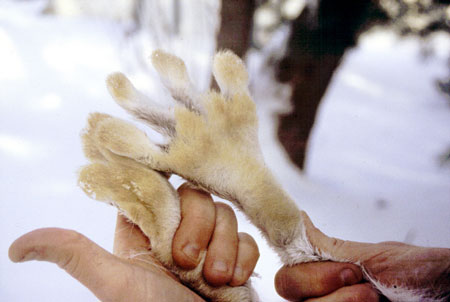 |
| As their name implies, snowshoe hares have large feet that allow them to easily traverse deep snow. |
Once you're ready to hunt, it's time to find your quarry. Fortunately, snow — the very thing that camouflages a winter phase snowshoe hare — also makes it easy to zero in on their cover. Just look for their tracks and droppings.
I head for the thick edge cover in the hardwoods to start — places where I might also look for grouse when in season. If there are any snowshoe hares around at all, you'll begin to cross tracks and scattered rabbit pellets. One set of tracks, however, doesn't necessarily mean anything. If they are leading into thicker cover, however, they are generally worth following. Hopefully, you'll soon find yourself in an area where the snow is criss-crossed with hare tracks and dotted with pellets. In central Ontario, where I live, these core zones are generally found in areas in and around low lying cedar swamps, on the edges of beaver ponds, or in old orchards where hawthorns and apple trees have gone wild. It makes sense, since these places provide food, seclusion, and cover from predators, which include fishers, fox, coyotes, lynx and owls.
Look for the Marbles
If you were in an area like this with a couple of good hounds, you'd probably step onto a piece of higher ground and wait for the ensuing chase to swing your way. When hunting alone or with a partner, however, you need to take a different approach.
I liken this to still hunting for deer. Ideally you want to see hares while they are still in their forms or loping along feeding calmly. They are often seen at the bases of trees, in thickets, or under blown-down trees. Generally this is cover where they can still see the surrounding area.
The old snowshoe hunter's adage is to look for their black marble-like eyes amidst the whiteness of the winter woods. Like most adages, there's good reason for this. Once you get used to searching these high percentage spots and begin looking for parts of the animal, such as the eyes or ear tips, it's amazing how many more you'll see. Sometimes, you'll catch them silhouetted against a dark trunk or log, but, most times, the first thing you'll see with be parts of them.
As in still hunting for deer, it's critical that you move calmly and quietly, and spend a lot of time searching with your eyes. It helps if you crouch down every few steps to get closer to their level too.
A Rifleman's Game
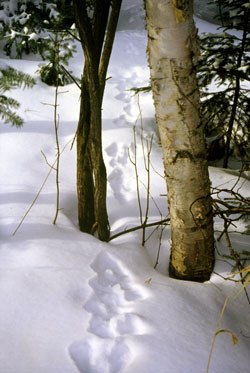 |
| One set of tracks doesn't necessarily mean anything; however, if tracks lead into thicker cover, they are generally worth following. |
Again, contrary to tradition, I prefer a rifle, rather than a shotgun. For one thing, my rifle is lighter, more compact, and easier to carry in the thickets. I use a .22 caliber lever action repeater, but there is a lot to be said for the reliability of a bolt action in cold weather too. Whatever your choice, you need to fire a few test rounds. Some small-bore rifles, especially autoloaders, do not work as well as they should in extreme cold.
I don't have a rifle scope because, in the country that I hunt, most shots are fairly close and you are never out there in low light. Speaking of light, sometimes, the sun on the snow is hard on the eyes. On days like that, a good set of sunglasses is worth its weight in gold.
When you see a bunny, try for a head shot, aiming right at their eye. Otherwise, behind the shoulder is a good bet. Either way, a well-placed .22 long rifle shell does the job quickly and humanely.
As previously mentioned, you should constantly check the muzzle of your rifle for snow. Even if you keep your muzzle up, sometimes snow from evergreen boughs falls on it as you pass under them. Some folks place making tape or stretch a balloon across the muzzle. Neither affects the shot but they do keep snow out. Most times, however, I can't be bothered replacing them after each shot, so I tend to be fanatical about checking my rifle's muzzle for obstructions.
Lastly, your rifle should be lubricated with graphite; this doesn't freeze or gum up in the cold. When you get home, dry it off thoroughly. No matter how hard you try to keep your rifle dry, it will get damp.
Conclusion
Make no mistake, hunting for snowshoe hares this way is a challenge. You'll cover a lot of ground and miss a lot of opportunities before you put one in the game bag. But you'll also enjoy the solitude and tranquility of the winter woods, you'll see the beauty of an untouched landscape, and you'll get an idea of how the early trappers felt. If you ask me, this beats cabin fever every time.
- 25412 views

